I’ve recently been writing about teaching my left hand to work again following my stroke. Because of this, I’ve been thinking very carefully about braiding hair, and knitting socks, about how it felt, and what it meant to re-instruct my hand (whose memory of habitual movement had been completely lost) in those activities. I’ve also been thinking about the hands of Albert Anker.
Anker is an artist much beloved in Switzerland for his depictions of village life, and the 1887 painting (below) of a young girl braiding her hair is one of his most famous works. The braiding is very interesting, of course, but what’s most striking about this painting, I think, is the fact that the girl is doing two things at once: her hands are working while her eyes are reading the book – most likely a devotional work – on the table in front of her. Her mind and hands are occupied.
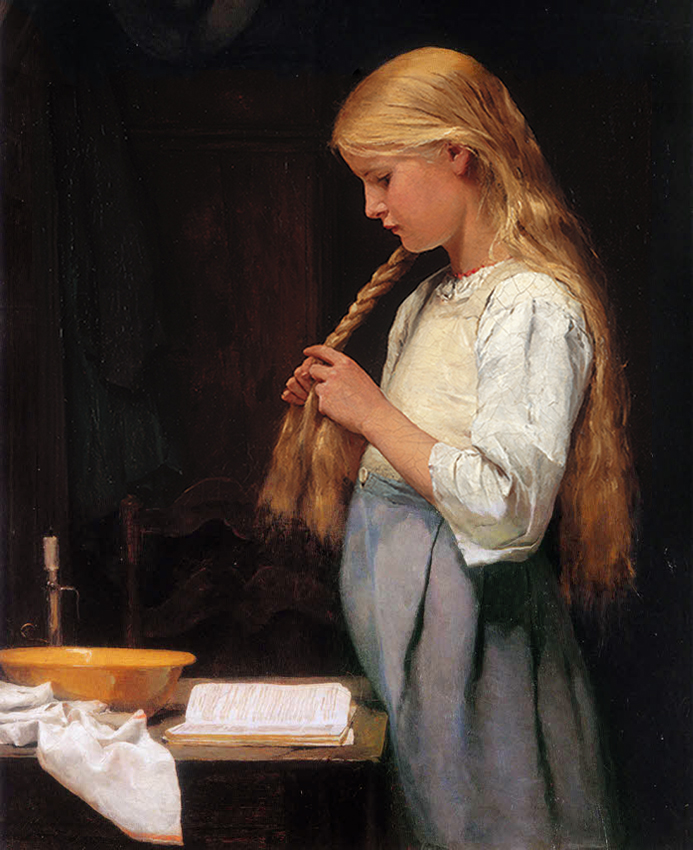
The busy working hands and minds of girls and women are a major theme of Anker’s oeuvre, but assume a distinctive prominence in the work he completed during the final decade of his life. In 1901, Anker had a stroke which paralysed his right side and affected his working hand. Seated at an easel, his right hand supported on the table next to him, he gradually re-taught his hand to work with watercolours rather than the more laborious oils which were previously his medium. Anker continued his life’s work, and, as his brain-damaged hand grew in strength and learned how paint again, he returned to the subject of women’s working hands again and again. . . and again.
Following his stroke, Anker painted women of all ages . . .
Spinning
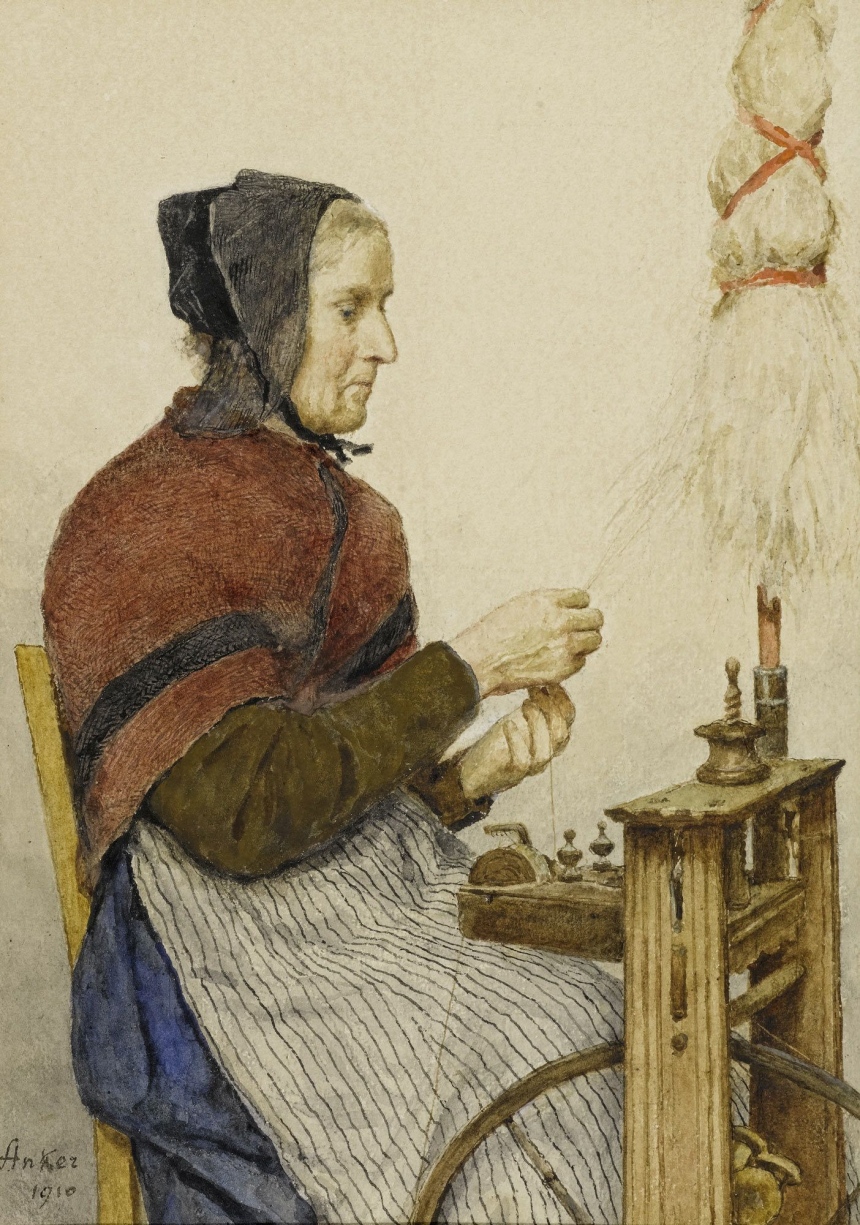
Sewing
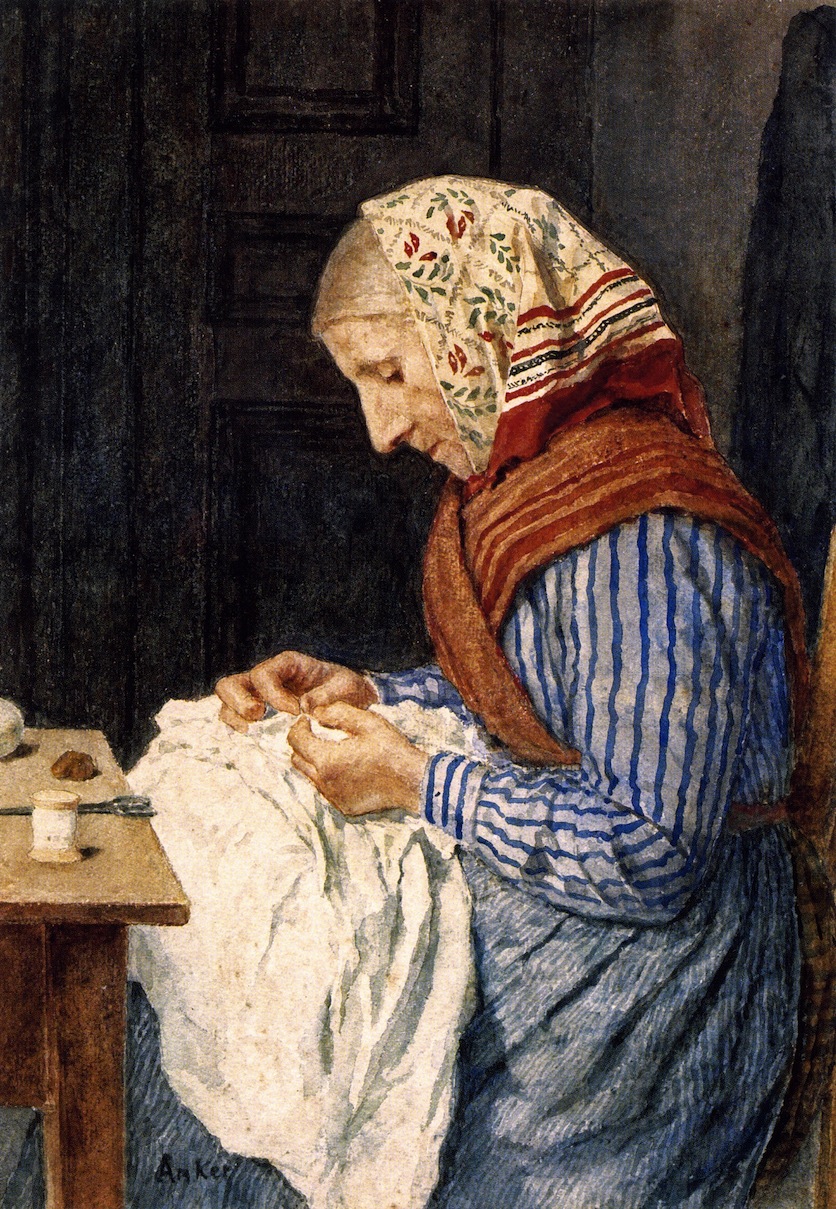
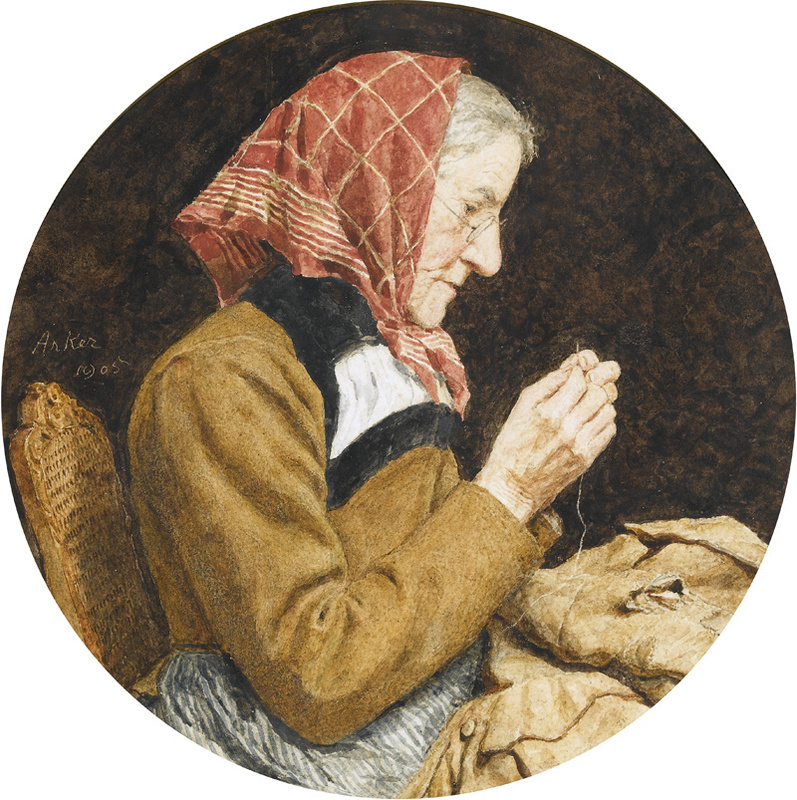
Knitting
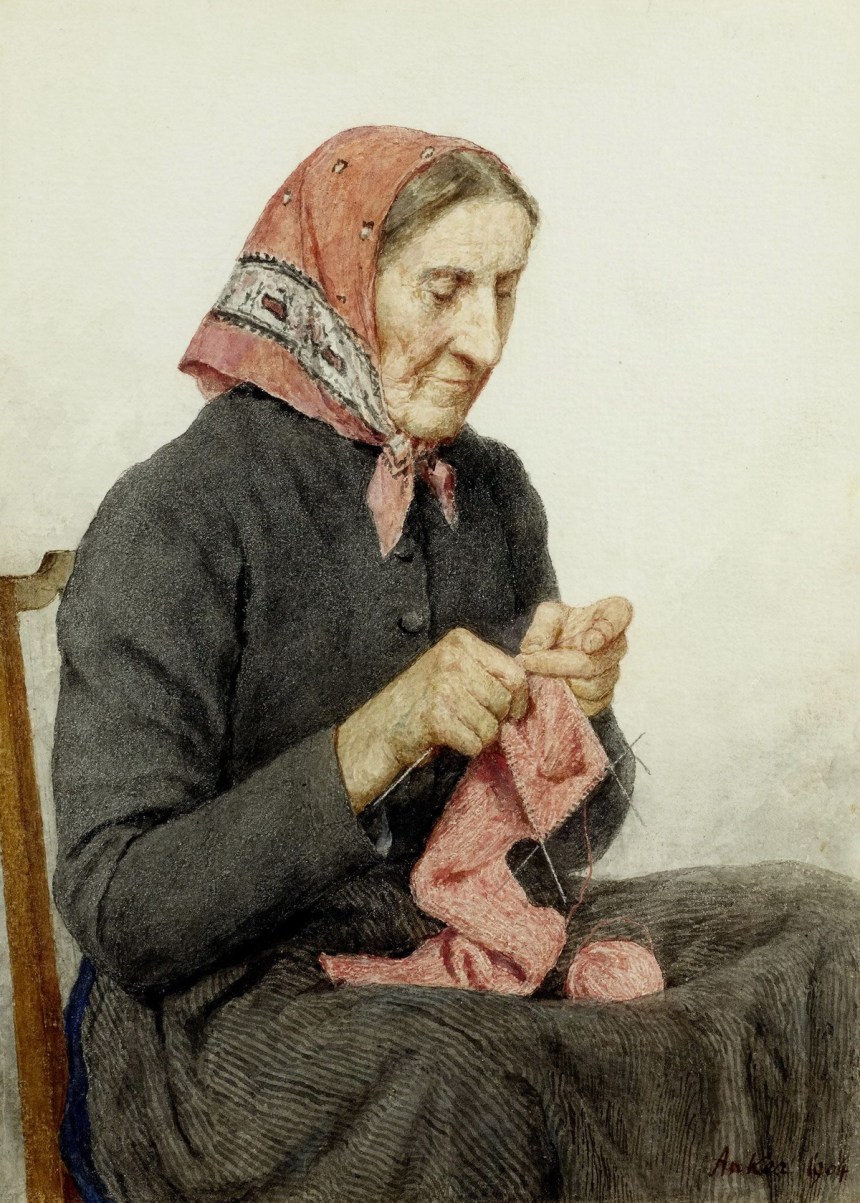
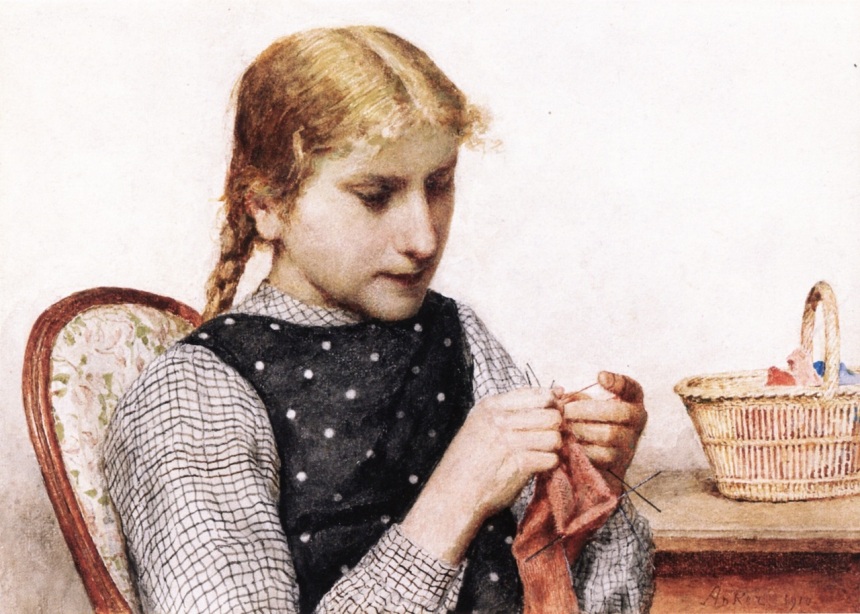
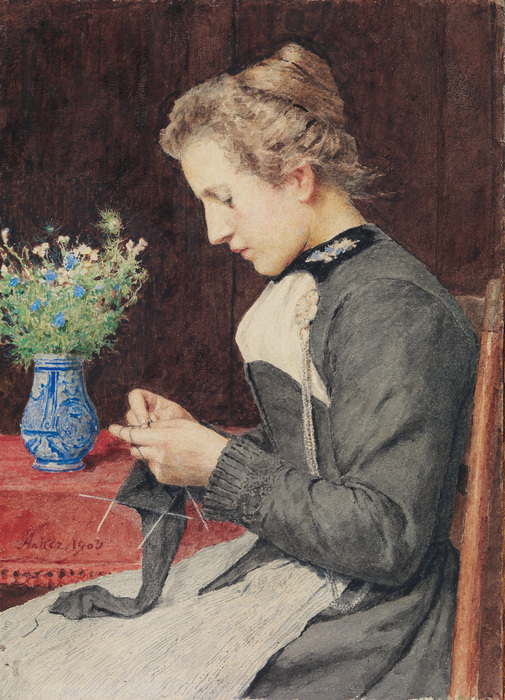
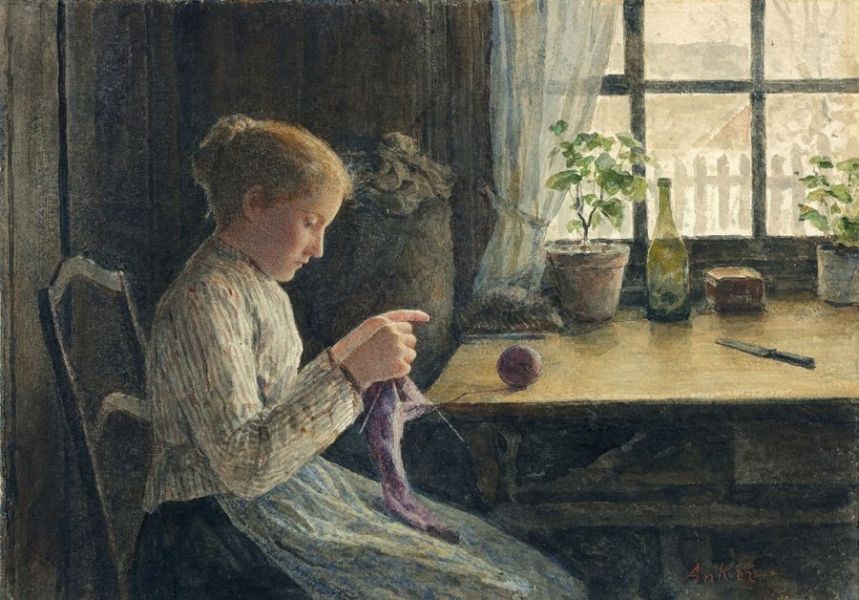
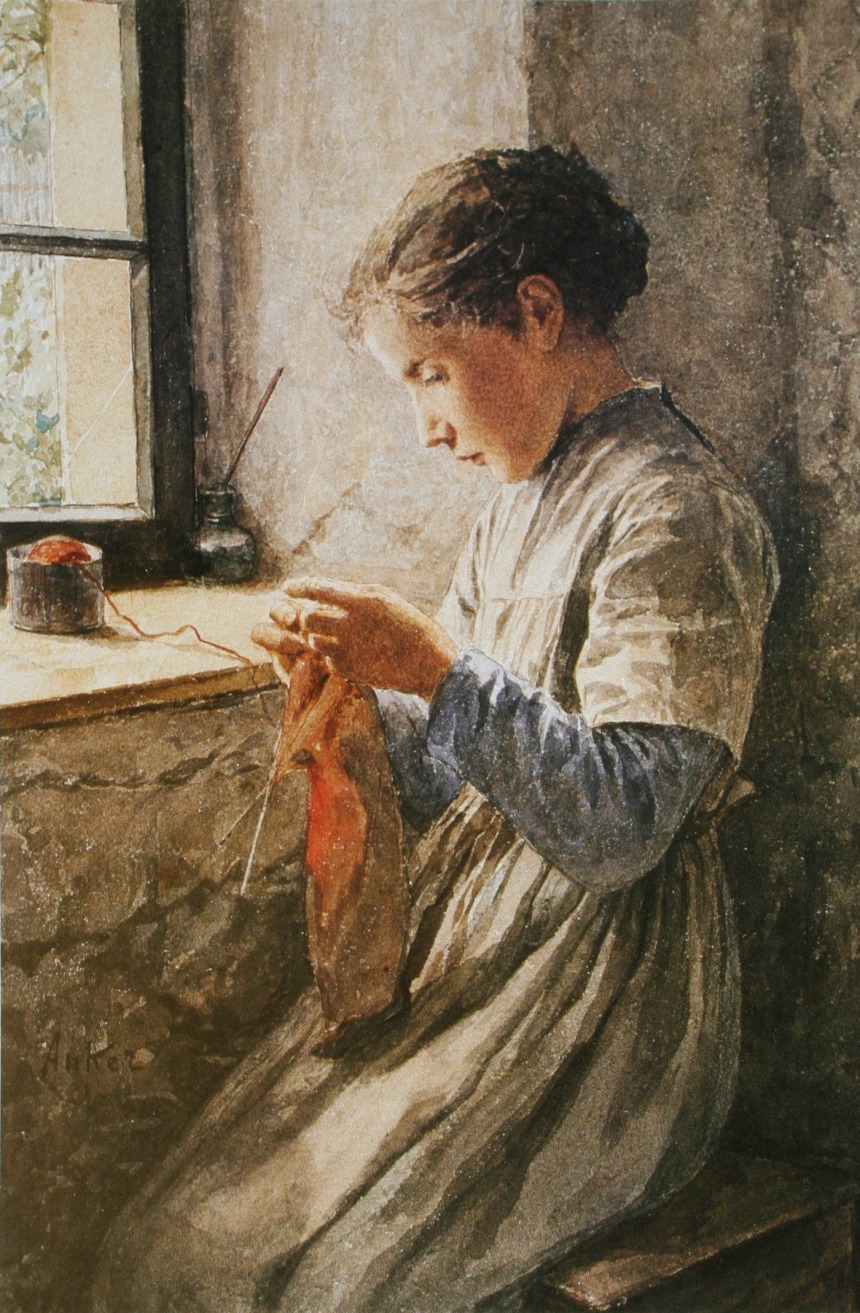
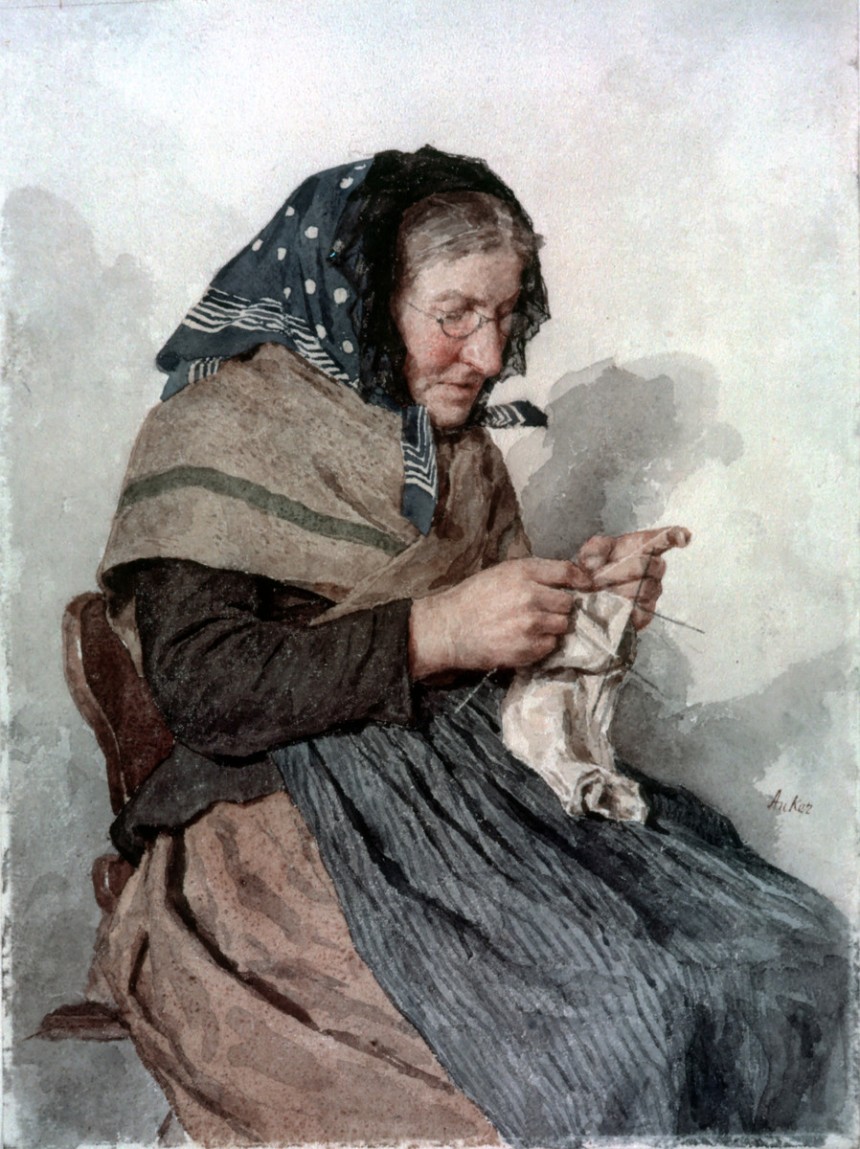
Reading
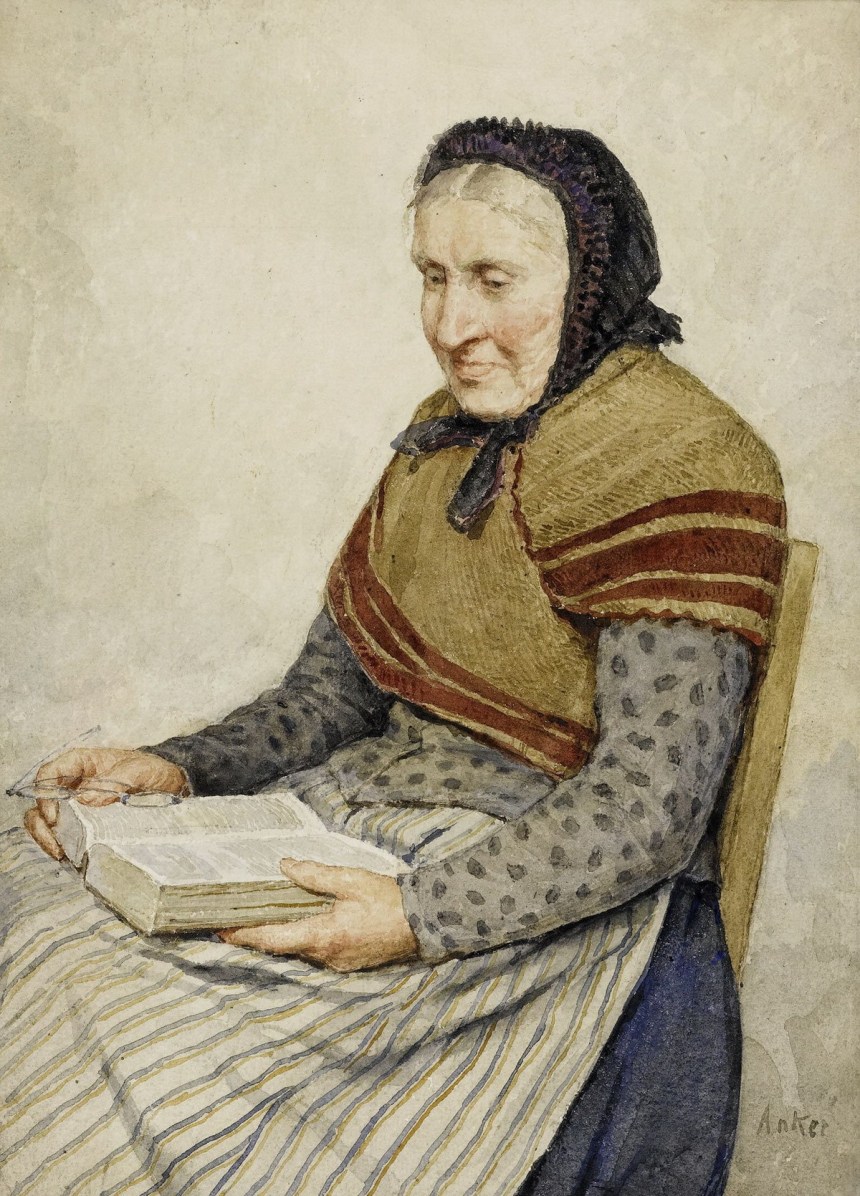
Or, in perhaps my favourite of Anker’s watercolours from 1903, knitting and reading
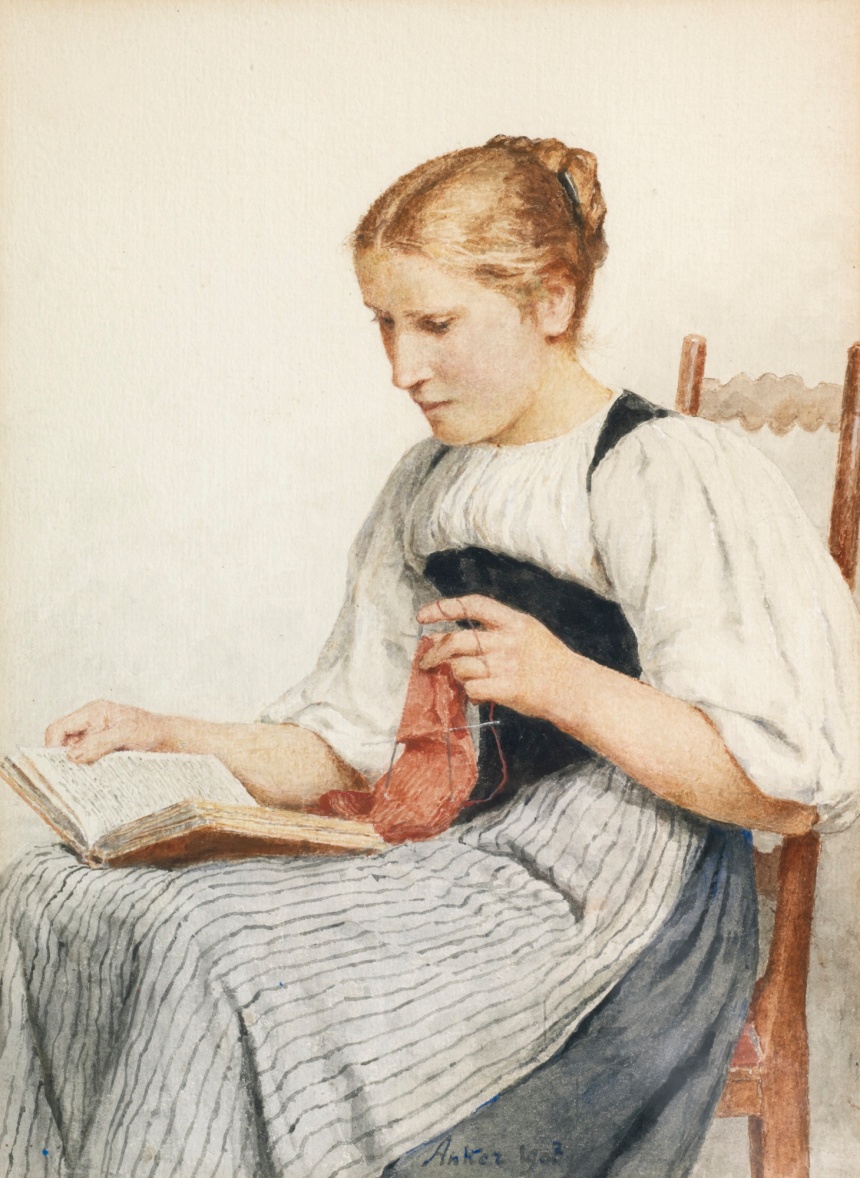
Teaching my post-stroke hand not just to function but to create again was one of the hardest things I’ve ever done. It was also one of the most rewarding. It has led me to regard the mental and physical processes behind my own working hands, as well as the hands of others, in a completely different light. I wonder if Albert Anker felt similarly.
All of these images, with the exception of the 1887 oil painting (held in the Kunstmuseum in Bern) are watercolours that Anker produced after 1903, which are now in private collections.


As someone who has helped do costuming for the mid-19th century, I find the art fascinating because of the detail he put into the clothing, especially the head kerchiefs. When making dresses or accessories for a by gone era, we can get into discussions of whether items are historically correct and some costumers will insist on a photo or it is not acceptable. He has certainly made costuming for his era a lot easier. Then to think he is adding that detail while reteaching his hand to paint…phenomenal!
LikeLike
Not to take away from the interesting self-recovery aspect of the post, but as someone currently painting from a paid model my first thought is that he painted these women as a captive audience. It would have been a close-at-hand source of subjects who wouldn’t have moved much! Similarly , Vuillard often painted his mother sewing or in her sitting room.
LikeLiked by 2 people
Maybe he got started by asking a woman to model and she asked if she could knit while modeling and that inspired him? I’m sure he was motivated to paint subject that was at hand, but the sheer number and variety of women as well as the activities they are engaged in suggests to me that he went out of his way to seek out women engaged in “women’s work”.
LikeLike
Thank you for showing us Albert Anker’s work, I was only vaguely aware of his paintings. The depiction of concentration and the working hands is beautiful.
I wonder if the difficulties he found after his stroke has increased the thinking before making a mark? Someone else commented about Watercolour as a technique needing a different thought process from oils. Really interesting.
LikeLiked by 1 person
I’ve always read while I knit, as long as the knitting isn’t too fiddly. I spin while I read as well, but in this case it’s easier to have the page on the PC. My DD, who has hair very similar to the girl in your first painting, is constantly braiding her hair into all sorts of braids and multiples while reading. She says she can’t do it neatly if she thinks too much about it.
LikeLiked by 2 people
that ‘not thinking about it’ is a thing that’s particularly interesting to me – the way our crafty actions become habitual / unconscious – – literally written in the brain!
LikeLiked by 2 people
I really enjoyed this post and I like how you related your own experiences with your hands to that of Anker’s.
LikeLike
Did you notice that practically all the knitting was in the round? And of socks?
LikeLike
Love this- thank you!
LikeLike
I agree with the positive responses to this post. I love Anker’s way with water color, infusing them with the kind of depth I associate with oils. His subject matter: my favorite.
I wasn’t familiar with his work. Thank you.
LikeLike
Thank you Kate, for the inspiration and the sight of those wonderful paintings.
LikeLike
This is one of your best posts ever. His paintings are beautiful!
LikeLike
Beautiful paintings and post, thank you Kate.
LikeLike
Such an interesting post here. As a teacher of special education (and a reader of body language), I was often surprised that my co-workers paid little or no attention to handedness and dexterity in our teenaged emotionally disturbed students. Most often with my left handed students or students with very poor or irregular handwriting I would find there was a story of interruption in the development and ability of the hand they were using. Often I would find they knew exactly when the interruption occurred and found that they felt they had never been able to achieve as much after that event. These kids didn’t experience stroke, by any means, but often a break or other incapacity, or a teacher making them use their right hand (yes that still happens). Sometimes it was just underused muscles, and in one case, a complete inability to use scissors. The gift of using tools, teaching kids how, why, and when to use tools was something I did right along with reading aloud to them. Now I know this is not what you are writing about here, but I think your understanding of the process of retraining your hand could be very informative to others working with ability and with re-abling people after trauma. In any case, I hope to read more.
LikeLiked by 1 person
Fascinating. Reading and knitting is one of my great pleasures in life, and I often have to stop and marvel and how both can be done at the same time … and that most people don’t know it’s possible. The brain, so amazing! But also, your comment makes me grateful for my ease in doing this and in my brain working smoothly generally. So much to be grateful for.
LikeLike
I particularly enjoyed this post…both for the artwork and for your comments about the restorative nature of activities such as knitting. Occupational therapists have been using these activities for over 100 years, but they fell out of favour as a rehabilitation method because they weren’t scientific enough. We are coming around again to understand the value of these ‘occupations’. Your post just reinforces, in such an eloquent manner, how beneficial these activities can be. Thank you for all your posts.
LikeLike
I am also an OT, and find that focusing on occupations helps clients improve function more than traditional exercise approach. If a person places value on an activity & finds enjoyment in it then they are more likely to be engaged the treatment, and be able to participate in collaborative goal setting.
LikeLike
Our Creator…amazing!
LikeLike
I enjoyed this post. However, having worked with oils and watercolors I would have thought controlling watercolors to have been the more difficult medium. :)
LikeLike
I’ve worked in oil and watercolor as well, and I was thinking that he might find the physical act of mixing color in watercolors less taxing. Mixing oils takes slightly more effort and strength, a real consideration for someone recovering from a stroke. Also, cleaning brushes of oil paint is more physically involved than swishing them in water. Small differences to people with full use of their bodies, but they might be real obstacles to people whose strength or mobility has been impaired.
LikeLiked by 1 person
Very interesting! As an illustrator, I really enjoyed learning about an artist new to me. It really looks like his models were probably family members, especially the girl with the blonde hair and the older woman- they have very distinctive features and their noses are very similar, and they also seem to age a bit through the pictures you’ve posted. His close familiarity with how they knit, the way they hold the yarn, the details of the spinning wheel and all really show his observational skills were all there even if he had to retrain his hand! I’d be willing to bet he kept a sketchbook where he did studies of hands, things like the wheel, folds in clothing, etc. Thanks for this.
LikeLike
I am very familiar with all these paintings and Albert Anker’s work (love all the wool-related ones) from various exhibitions but I didn’t know he’d had a stroke, so that was a very interesting new piece of information. I’ll be taking out my Anker catalogue this evening and comparing the before/after pictures with that in mind. Thankyou!
LikeLiked by 1 person
Molto bell! Very beautiful!
LikeLike
the official US medical research facility ways in on the benefits of stitching.
https://www.washingtonpost.com/national/health-science/might-crafts-such-as-knitting-offer-long-term-health-benefits/2014/04/21/d05a8d40-c3ef-11e3-b574-f8748871856a_story.html?utm_term=.467abde1d138
LikeLiked by 1 person
see also benefits of knitting for male prisoners.
https://www.washingtonpost.com/local/2014/04/24/a814362a-ae0e-11e3-a49e-76adc9210f19_story.html?utm_term=.d7458f90364e
LikeLike
weighs in on. jeez.
LikeLike
I remember learning in art at school that it is very difficult to draw/paint hands. All the hands in these paintings look completely natural. You have worked so hard to recover from your stroke – you are an inspiration.
LikeLike
Thank you for this post. I was unfamiliar with this artist and I am thrilled to have new works to explore and enjoy. I am also bolstered by his and your story. I struggle with problems in my left arm after shattering my elbow. You always inform and inspire.
LikeLike
Fascinating artwork and always such interesting insight! Thank you for sharing your thoughts, progress, and processes.
LikeLike
Love your curiosity. As a paediatric nurse, I was able to engage in play therapy and I encourage you to consider the tasks of unwrapping candies, picking flowers and throwing a ball as part of your activities.
LikeLike
I am always moved by your thoughts and perseverance. May you continue on your long journey successfully. You are truly an inspiration for all of us. Anker’s perseverance was very special because medical science at that time would have given up on his ever returning to his art. I have the deepest admiration for you and for Anker. Thank you very much for sharing these lovely paintings
LikeLike
Incredibly interesting, Kate. As a painter (and I know that I’m not alone in this), I find that watercolors require not just a different technique but a different thought process. I wonder if he chose this in part because of the dissimilarity from his previous oils.
LikeLiked by 1 person
Such a blessing this morning too read this. You are an inspiration to so many, and the pictures are so wonderful! May our God continue to bless and restore all who suffer! Continued good health!
LikeLike
I wonder if he was aware that he was focussing in on hands or ‘assumed’ he was continuing the genre /pastoral work. Plus how significant is it that these are woman who are not looking at him, these are domestic and female sitters who are prob/obv not patrons. Thus he might have felt less self conscious about retraining his hand/artistic touch, his artistic persona not at threat?
LikeLike
Such a lovely post – Thank you. Such wonderful pictures and what determination from you to get your hand working again. <3
LikeLike
Thank you, another interesting, thought provoking post. The art is beautiful. I love the intense concentration on the face of the girl knitting, and I love that more than a hundred years ago these women were reading and knitting. I really enjoy reading and knitting,if it is a simple pattern and I can get the book to stay open (this is the biggest problem!).
LikeLike
I have a number of ‘reading pebbles’ chosen because their weight, size and smoothness are just right for weighing down the open pages without obscuring too much text. I encourage you to experiment!
Another Helen
LikeLiked by 1 person
there’s a wonderful book holder called a Gimble that solves this problem easily and rather elegantly. I highly recommend it!
LikeLike
Big bulldog clip? That’s what I use.
LikeLike
What beautiful inspiring images, Kate, even more beautiful because of their everydayness and the story behind the painter you’ve described. I wonder if the painter was as struck, as I am, by the gaze of the women and girls, the concentration on their faces, the peacefulness in their presence and care in their activity. A true head, heart and hands experience for both sitters and painter. Looking forward to further insights into your recovery. All the best, Ax
LikeLike
This is such an interesting coincidence! I was recently diagnosed with ADD and autism, and have been reading a lot about the human brain as a result. This has led me to looking up literature on how the use of the hands for making things, playing music, or other creative activities, has been one of the main factors in the development of the human brain over time, and I was ordering books on precisely this subject before I went to check your blog… It is interesting for me both personally as a knitter, and professionally as an archaeologist who studies prehistoric crafts. There is such a lot of interesting research on the brain going on right now! I really enjoy your posts about your research, and I’m looking forward to the book!
LikeLiked by 2 people
Its a really interesting field, Karin! If you’ve not read it, I think that you’d enjoy Lambros Malsfouris, “How things shape the mind: A theory of material engagement,” (2013)
LikeLike
Thanks, Kate! I’ll look it up!
LikeLike
Interesting post.
I notice that nearly all of the subjects were sitting on hard, utilitarian chairs. No comfy armchairs for a bit of relaxing stitching.
Fabulous paintings.
LikeLike
I’ve heard that furniture in general was much harder & straighter-backed in the past because women wore corsets and really could not sit in a “comfy” couch or soft chair. Upright posture was important for men to have as well, though they didn’t have corsets to “help” them. Uprightness in posture and morality were linked in the mind in that era…
Also of course, padded/upholstered furniture would have been much more expensive at that time as well!
LikeLike
Thanks Kate. Such beautiful paintings and and artist completely unknown to me. One of the things I have always enjoyed about knitting is that I can do other things at the same time like read, join in conversations and watch TV. Other hobbies require more concentration or a specific location. I am knitting the Uncia hap at the moment though and it needs very close attention and I’m loving it. Watching the patterns and tracery emerge is very revealing and gradually I’m starting to be able to anticipate where it is all going and take my eyes off the pattern a bit. Your descriptions of teaching your brain how to perform tasks that were habitual before your stroke are absolutely fascinating and very inspiring. I’m sure your writing will be a huge support to others.
LikeLike
What an emotional post! But so recognizable for me, I had breast cancer 22 years ago and afterwards I had much problems with my left arm, I had much lymfnode problems there with lymf fluid that has to be removed by massage and still every week, it stays. But at that time I wasn’t allowed to knit and after 10 years I restarted with knitting socks and allowed myself to knit every day 3 rounds and as my arm stayed the same, I allowed to do it twice a day and so I built up my knitting very slowly and now I can knit again as much as I want without problems. In the time I couldn’t knit I did cross stitch because that didn’t burden my arm. So don’t give up!!! Slowly you’ll get there, but it will take time…
LikeLike
As ever, so inspirational. I am full of admiration for your tenacity and courage.
I discovered Anker’s paintings a while back on Pinterest of all places, and have saved the ones involving craft. So lovely.
Best wishes.
LikeLike
This is a beautiful post, but I must admit I was rather excited to see several of the knitters he painted with the working yarn *double-wrapped* around their left index finger, which is how I usually carry the yarn when working with a single color (and it’s something I don’t see very often).
LikeLiked by 1 person
This is the way considered “correct” by Swiss handicraft teachers: here, it is very much a case of right or wrong, which I am constantly trying to remedy! Having said that, I also knit this way, having been taught by my teenaged Swiss friends 30 years ago when they couldn’t control their laughing at my “awkward” (as they saw it) English style of “throwing” in my knitting… though I alternate when colour knitting, one thread in each hand.
LikeLike
To clarify, you mean that the double-wrap around the index finger is explicitly taught, not just knitting continental style in general? That’s a pretty thrilling tidbit to learn! I learned continental and never got the hang of English, so I carry both yarns over my left index finger when stranding.
LikeLike
Yes, they really teach you this detail in deep. Our daughter is fighting every Wednesday with her teacher, because she wraps her yarn multiple times (“better control, Mama”). Yesterday it did happen, even tough it is not my habit, I did wrap my yarn a lot of times for a little moment, and both Primary-Kids shouted on me: You know, it’s the wrong way, do you?
I think, her teacher is overachieving, but have to say: I’m happy, they teach the kids knitting and crocheting, because crafting is disappearing in the last 10 years, even in primary school (in Germany). Switzerland is really way behind this trend.
LikeLiked by 1 person
Thanks so much to both of you for sharing! That’s really fascinating.
LikeLike
It seems to depend a lot on the teachers’ skills – two of my three daughters were taught to knit at school in northern Switzerland and still knit (in fact, girls and boys!) while the youngest had a teacher who didn’t knit and so didn’t learn. While on holiday in the mountains I visited a LYS where I was told ALL the girls are still taught the traditional knitting, crochet and embroidery skills… so perhaps it also depends on what region you’re in.
LikeLike
Adding my agree. I was taught the same way, by my mother whose mother was Swiss.
LikeLiked by 1 person
I find that insight fascinating, perhaps because I sometimes have to consciously think about “how” I am going to do something that other people would just do (I assume) without consciously thinking about it.
LikeLike
What gorgeous work! I had not seen these paintings before and they are certainly powerful. I am always moved by people who must create even when their body makes it difficult whether it be Beethoven losing his hearing or Renoir suffering terrible arthritis, Degas’ sight impairment and Milton of course.
Thank you for yet another wonderful and thoughtful post.
LikeLike
I love this! Thanks for sharing. When I couldn’t sing any more I started to play the organ more seriously. Art will out.
LikeLike
Lovely–and inspirational–images
LikeLike
Thanks Kate for your writings, you are truly an inspiration to all those who have gone through having a stroke and having the grit and courage to work through rather than give up. Keep uo the good work. Also the paintings are amazing. Just show what the body is capable of when put under pressure and having the will power not to give up under adversity.
I’m writing this whilst watching the ceremony at Gallipoli for all our lost Anzacs. Makes me very proud to bean Australian.
LikeLike
I love your stroke-recovery posts, as I am going through it myself. You are inspirational to me, as I try to get back to knitting. I cannot wait for your book.
LikeLike
yeah me too! mine was a year ago and I’ve e no function in my keft hand so I’m watching Kate’s progress with great interest, I’ve e always been a maker so I miss it very badly, not a knitter though
hiw are you doing?
Tony
LikeLike
I was moved by this. Thank you.
LikeLike
Wonderful paintings! I was not familiar with this artist, but love it that he pictures everyday people and subjects, of course including knitting!
LikeLike
I love that as a gallery of women’s clothing!
LikeLike
The paintings reflect the traditional dress of the Bern, Switzerland region with the high yoke, not seen in other regional costumes here.
LikeLike
such an important and thoughtful post kate. thanks so much for sharing. and i’m excited to learn of albert anker’s work. it’s incredibly beautiful and meaningful.
LikeLike
These pictures are extraordinary. I love them. Thank you. And the haps are lovely as are all the images of hand work.
LikeLike
Thank you for sharing these beautiful and touching paintings, and for sharing some history of the amazing artist.
LikeLike
Fascinating. Looking forward to this book of yours.
LikeLike
Maybe an odd comment, but it struck me how almost all these women have quite good posture, young and old-sitting on straight backed chairs as they knit.
LikeLike
Thanks for post. So interesting. I had no idea about your hand and here you are knitting and I think I have problems with arthritis. You are truly amazing. Thanks for pics too.
LikeLike
What really lovely watercolors! And aren’t many of them wearing haps?
LikeLike
What an amazingly kind eyes of an artist looking at those women… On the practical side of things, if one is trying to retrain one side of the body, starting with the same movement on the stronger side, and than doing it on the weaker one will produce something called contralateral neurological transfer that improves weaker side much faster then work in isolation. Knitting must produce a reciprocal transfer of that kind, I think :-).
LikeLiked by 1 person
You are amazing! I so enjoy your blogs. Makes my recovery from back fusion seem “piddlely” and inspires me to get out there and work! (I’m a quilter and great admirer of knitters!) My British friend laughs at my knitting attempts but that’s alright.
LikeLike
glad you’re writing about this. the actual neuromotor healing facts of stitching, as well as the psychiatric benefits of repetitive motion (?), are woefully under researched and described. instead, we have the zen of knitting (with which i sort of concur but fear quackery and snake oil in the writing thereof). i can’t wait to read and buy this book of yours as you have never steered me wrong (bill brown, Rozsika Parker, Vladimir Arkhipov) and so many more. strength to your neurons!
LikeLike
and of course you know about the work of social worker kathryn duffy, including published research, on stitching as therapy for recovering addicts and alcoholics at interim house in philadelphia.
http://www.tandfonline.com/doi/abs/10.1300/J384v02n01_04
http://mcduf.blogspot.com
http://www.interimhouse.org/index.php/knitting-blog
LikeLike
I had to teach my right hand to work again following my fall which broke my hand in two places gave me a tfcc tear and an ulnocarpal and radioulnar ligament pulled out on my hand.It lay there after the fracture healed,useless and in pain.10 minutes physio movements every hour every day for months started to show results and the pain lessened. Knitting was slow,my felting even slower but again it got stronger over time.There are things my hand cannot do and it certainly does not have the strenth it should or the dexterity, but it works and the satusfaction comes from little things like washing my face,holding my cup brushing my hair.
Being able to knit, felt,crochet,bead and garden are all bonuses the thrills are holding my Granddaughters’s hands.
We never fully appreciate parts of our bodies until they stop working.
I am glad your journey has had a good ending and you are healing and enjoying your craft work.
LikeLike
Hi Kate – thank you so much for sharing these portraits. I have never heard of the artist but I find his paint, both pre and post stroke, mesmerising. The subjects show there is true beauty in the female form and the artist shows that rehabilitation using occupation is truly inspiring
LikeLike
Kate, thank you for sharing Albert Anker’s story and these paintings. Did you know his story at the time that you were relearning to knit? If so, it must have brought you some comfort to know that relearning was indeed possible. (Also, I like the haps that are worn by some of the women!)
LikeLike
Those are lovely paintings. The brain is amazing in it’s plasticity. My brain is wired differently to the norm, (I am on the Autistic Spectrum) and it took me a long time to reprogram it to correct the dyslexia it produced. Then after an attack when I suffered PTS it suddenly reverted back to the original settings and I had to re-learn all the skills I had worked so hard to acquire, but I did get them all back. (With the exception of map reading that I still see in reverse, but I am working on that.) There is a lot of research being done about those on the spectrum and early intervention with physical exercises to re-pragram brain function is making a big difference to the lives of those children.
LikeLike
Gorgeous paintings.
LikeLiked by 1 person
Lovely paintings, I particularly enjoyed the detail of the fabric
LikeLike
Seeking the hands and women paintings by this artist is a tribute to the hard work you’ve done to bring your hand back to being creative. The paintings are stunning and I wish there were small prints available.
LikeLike
What a joy in reading your thoughtful words!
LikeLike
Thank you for sharing these wonderful paintings. Much appreciated.
LikeLike
Kate you are an amazing woman.brave, talented, brilliant and caring. Please know that you touch many lives as you live your own.
Julie
LikeLiked by 1 person
Your posts about your recovery from your stroke always interest me. I often wonder if you’re aware of the courage it takes to get from where you started to where you are. I know for sure you’re aware of the frustrations, the joys, the triumphs, and I’m sure the failures. I wonder too if there are days you grit your teeth, say a few swear words, and simply refuse to give in to an urge to lie in bed all day. This particular post though brings to mind a short sharp, terrifying, to me at least, struggle of my own. A few visits to a chiropractor for pains in my shoulder, corrected the problem but he was convinced that I was left handed because my left side was so much stronger and more coordinated than my right side. A few more visits to correct that problem left me utterly unable to tell my left side from my right side. I could no longer write, use a key board, drive, knit, read, or do much of anything. It was terrifying. I had to stop working. When I talked to my father about it, he remembered a time when I was very young something was ‘off’ but then it just ‘went away’. Anyway, after about four months, my problem ‘went away’ without me having to do any of the work you’ve been doing. Well done you!
LikeLike
Kate
Thank You!
Your research is Fascinating!
Do you know the book “The Hand” by Frank R. Wilson? Also, “Knit for Health& Wellness” by Betsen Corkhill?
LikeLike
thnk you kate, Im not a knitter but was uied ti yoyr blog by a friend and have taken encouragement from it i had a stroke almost exactly a year ago and lost tge use of ny left leg and my hand, ive alwata veen a maker so this is a big loss, i was always a jeen walker and the los of my ability to walk was a cause of great grief, but I am slowly recovering that ability and my strength inprives slowly i aldso had tgw fatigue issyes you described so well. beginning to lift now.
i often wondered how you managed to i create with one and not functioning but I guess we both know that in spite of the intense frustration the stroke causes, there is always hope of recovery because of the amazing way our injured brains can heal themselves. I will be following your story ab your recovery if your gand wuth great interest and I wish you success and joy, invrecovering your creative friend, whom ii am sureyou have missed sorely.
LikeLiked by 3 people
Love the paintings…. and the fact they are knitting socks…. how beautiful they are!! Love your post!! Thanks!!
LikeLike
This is beautiful Kate. I’ve recently subscribed to a blog entitled ‘reading and art’ which is just paintings of people reading.
LikeLike
Such an amazing development. It’s interesting to read about regaining abilities and how to become creative again.
LikeLike
Thank you for the gift of these paintings; they are beautiful in their depth and simplicity.
LikeLiked by 1 person
The hands in these paintings are amazing, especially those of the lady in the headscarf sewing!
V x
LikeLike
What lovely paintings! I love the haps the older women are wearing. And look at them all knitting socks!
LikeLiked by 1 person